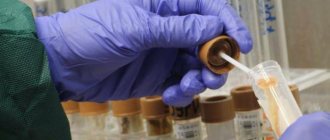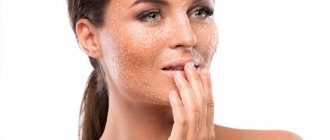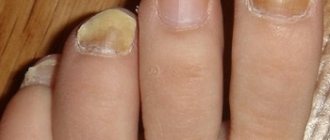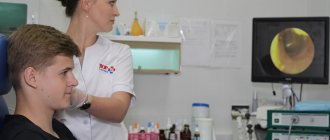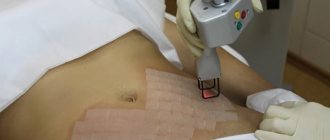General information
Acanthosis nigricans (ICD-10 code: L83 in Latin - acanthosis nigricans) is hyperpigmentation of the skin, which most often occurs in the folds of the skin - in the axillary area, in the groin, as well as on the neck and other areas.
Most often, acanthosis nigricans - dystrophic papillary pigment changes of the skin is diagnosed in young people - under 40 years of age (with the exception of malignant), suffering from obesity or endocrinopathies, including hypo- and hyperthyroidism , acromegaly , insulin resistance , polycystic ovary syndrome , diabetes mellitus and Itsenko's disease. Cushing .
Risk factors
Acanthosis nigricans can affect people of any age (including children) and all ethnic groups. However, it is more common in adults and people with darker skin, such as Native Americans, Hispanics and some African populations. Men and women suffer equally.
People most susceptible to developing acanthosis nigricans are:
- people who are overweight or obese;
- subjects with endocrine or metabolic changes;
- patients who regularly take certain medications (eg, oral contraceptives, systemic corticosteroids, etc.);
- subjects who have undergone kidney transplantation;
- people with a malignant tumor on an internal organ (a very rare cause of acanthosis nigricans, especially malignant ones).
Pathogenesis
Acanthosis nigricans in humans is characterized by symmetrical hyperpigmented foci of hyperkeratosis and papillomatosis , predominantly affecting skin folds. Initially occurring hyperpigmentation against the background of dryness and roughening of the skin subsequently acquires a grayish-black slate tint, folding of the skin, numerous and small villous and warty formations are formed. The spread is usually gradual and symmetrical over the years, and may be accompanied by dry hair, nail dystrophy, and increased keratinization of the surfaces of the palms and soles. The changes are quite often caused by the long-term effect of insulin on keratinocytes - the binding of insulin molecules on the surface of the epidermis to receptors for insulin-like growth factor.
At its core, malignant acanthosis nigricans is an obligate paraneoplastic dermatosis .
Paraneoplastic processes in the body cause skin lesions and a complex of symptoms. The pathogenesis is based on the processes of cellular proliferation of keratinocytes caused by blastoma growth. Chronic inflammation also creates a favorable background for the development of neoplasia. In this case, the inflammatory response is usually directed not only at the tumor, but also at molecules that are expressed in the epithelium and cause paraneoplastic changes.
Classification
Depending on the prognosis, human acanthosis nigricans is divided into clinical forms such as:
- juvenile (primary) - usually diagnosed in childhood or early adolescence and is not associated with endocrine disorders, is considered benign, the rash may regress or remain stationary, is transmitted through an autosomal dominant mode of inheritance;
- medicinal (like all subsequent ones is secondary) - occurs during therapy with diethylstilbestrol , glucocorticoids and overdoses of nicotinic acid ;
- pseudoacanthosis - typical for obese women, more often brunettes, with dark skin, often suffering from ovarian dysfunction, excessive sweating leading to skin trauma; in some cases, regression can be achieved by reducing body weight;
- symptomatic - can be combined with obesity and be associated with hereditary diseases, usually develops against the background of taking estrogens and glucocorticoid hormones, as well as endocrine diseases ( hypothyroidism , type 2 diabetes , Itsenko-Cushing's disease , etc.);
- malignant - observed in people after 40 and develops against the background of oncological processes, accompanied by the production of tumors of various factors that stimulate epidermal growth, most often these are carcinomas of the stomach , cancer of the urinary tract and genital organs, this form of the disease is characterized by clearly pronounced hyperkeratosis of the skin on the palms and soles .
Prevention
The best way to prevent acanthosis nigricans is to keep yourself in good physical shape and adopt a healthy lifestyle.
You should also adhere to the following rules:
- periodically visit a dermatologist for a routine examination and blood donation;
- do not resort to self-medication;
- at the slightest suspicion of problems with the endocrine system, contact the appropriate specialist;
- monitor blood sugar levels;
- do not take medications without medical prescription.
Causes
Conditions of different origins and pathogenesis can lead to the development of acanthosis nigricans. Although there is an understanding of the mechanisms of skin lesions, the etiogenesis of this dermatosis has not been thoroughly studied. Presumably acanthosis nigricans is provoked by:
- malignant formations;
- insulin resistance;
- hormonal imbalance (hypo- and hyperthyroidism);
- Addison's disease;
- Itsenko-Cushing's disease;
- obesity and polycystic ovary syndrome ;
- taking diethylstilbestrol , glucocorticoids and overdoses of nicotinic acid ;
- autoimmune disorders, such as Hashimoto's thyroiditis ;
- family genetic predisposition.
CONTENT
- 1 Signs and symptoms
- 2 Reasons 2.1 Type I - family
- 2.2 Type II - endocrine
- 2.3 Type III - obesity and pseudoacanthosis nigricans
- 2.4 Type IV - drug related
- 2.5 Type V - malignant neoplasm
- 2.6 Acral acanthotic anomaly
- 4.1 Differential diagnosis
Symptoms
The symptom complex of this dermatosis includes:
- local increase in skin pigmentation;
- thickening of the skin in the folds of the body, for example, in the groin and axillary (axillary) area, on the elbows and on the neck;
- unpleasant odor and itching in affected areas;
- strengthening of the skin pattern due to dirty gray papillary growths.
In almost half of the patients, growths with a villous, warty structure can be seen on the oral mucosa and genital organs.
Photo of acanthosis nigricans of the axillary zone
HAIRAN syndrome and acanthosis nigricans in humans
Warty keratinizing growths, as in the photo of acanthosis nigricans in humans, usually occur in places of friction and areas of skin folds, including only the armpits, submammary folds, groin, perineum, but also the neck. Acanthosis can be combined with insulin resistance, hyperandrogenism , amenorrhea and obesity , which together gives HAIRAN syndrome (in English HyperAndrogenic InsulinResistant Acanthosis and Nigricans syndrome ).
Acanthosis nigricans, in the form of HAIRAN syndrome, occurs in approximately 1–3% of women who exhibit signs of masculinization such as changes in male hair type and enlargement of the clitoris.
Acanthosis nigricans in dogs
Canines can also develop acanthosis nigricans in rare cases. In dogs it can be primary or secondary. Primary genetic dermatosis causes bilateral hyperpigmentation, alopecia and skin changes in the axillary and then in the ventral region, develops against the background of inflammatory dermatoses and occurs only in smooth-haired dachshunds aged 6-12 months. Pathology can lead to lichenification and secondary seborrhea , seborrheic odor, secondary bacterial infection, erythema and pain.
Acanthosis nigricans in a dog
The development of secondary anactosis is preceded by any inflammatory processes on the skin of the ventral part of the body. Thus, such hyperpigmentation is post-inflammatory, does not require specific treatment and disappears spontaneously after the inflammatory dermatosis is cured.
If acanthosis in a dog becomes malignant, then symptomatic treatment is ineffective.
What is the prognosis if affected by this disease?
It is impossible to make an unambiguous prediction about a person’s condition after a full course of treatment. Whether he will fully recover or not depends on the type of pathology:
- In a benign form, if the primary source is identified in time and managed to eliminate it, then the symptoms may disappear completely or begin to regress intensively. If it manifests itself in adolescence, then after puberty the disease disappears completely.
- In the case of a malignant form, the scenario is often unfavorable due to the rapid metastasis of the tumor. Even with high-quality treatment, the patient is given no more than 2 years of life.
- In the case of pseudoacanthosis, most patients recover after returning their weight to normal.
Childhood and juvenile acanthosis is mostly benign and does not have negative consequences.
Plastic surgeon Daniel Barrett
But in middle-aged and elderly patients there is a high probability of this type of dermatosis developing into seborrhea and fungal infections. Especially if the form is malignant.
At the first signs of acanthosis nigricans, you should immediately consult a dermatologist. It should be remembered that this type of dermatosis can signal more serious malfunctions in the body.
Tests and diagnostics
To diagnose acanthosis nigricans in a person, it is necessary to identify 3 symptoms - hyperpigmentation , papillomatosis and hyperkeratosis . To do this, histological examination of biopsy samples is carried out. In this case, in the dermis one can detect uneven hyperplasia, expressed differently in different parts of the epidermis, papillary hypertrophy and a slight perivascular infiltrate of an inflammatory nature.
General blood and urine tests may also be taken, and a general health examination may be prescribed.
Links[edit]
- "acanthosis nigricans" in Dorland's Medical Dictionary
- ^ a b c d e
Higgins, SP;
Freemark, M; Prose, N.S. (September 15, 2008). "Acanthosis nigricans: a practical approach to assessment and treatment." Online Journal of Dermatology
.
14
(9): 2. PMID 19061584. - ^ B s d e g h i J
Habif, Thomas P. (2009)
. Clinical Dermatology
(5th ed.). Edinburgh: Mosby. ISBN 978-0-7234-3541-9. - ^ a b c d e f g h i j
Thomas B. Fitzpatrick;
and others. (2005). Fitzpatrick Color Atlas and Synopsis of Clinical Dermatology
(5th ed.). New York: McGraw-Hill Medical Pub. Separation. ISBN 978-0-07-144019-6. - ^ a b c d
James, William;
Berger, Timothy; Alston, Dirk (2005). Andrews' diseases of the skin: clinical dermatology
. (10th ed.). Saunders. ISBN 0-7216-2921-0. - ^ a b c
Rapini, Ronald P.;
Bologna, Jean L.; Iorizzo, Joseph L. (2007). Dermatology: 2-volume set
. St. Louis: Mosby. ISBN 978-1-4160-2999-1. - “Nueces County Medical Society | Health Education - Insulin resistance and acanthosis nigricans in children." www.nuecesmedsociety.org
. 2018-04-12. Archived from the original on 2018-04-12. Retrieved March 1, 2021. - Verma, Shyam; Vasani, Resham; Joshi, Rajeev; Fiske, Megana; Punjabi, pritesh; Toprani, Tushar (2016). "A descriptive study of acanthosis nigricans facialis and its association with body mass index, waist circumference and insulin resistance using HOMA2 IR". Indian Online Journal of Dermatology
.
7
(6):498–503. DOI: 10.4103/2229-5178.193898. ISSN 2229-5178. PMC 5134163. PMID 27990384. - Rigel D.S. Jacobs M.I. (1980). "Malignant acanthosis nigricans: a review." J Dermatol Surg Oncol
.
6
(11): 923–7. DOI: 10.1111/j.1524-4725.1980.tb01003.x. PMID 6257767. - ^ a b
Ngan, Vanessa. "Acanthosis nigricans". Retrieved August 23, 2013. - Schnopp C; Baumstark J (2007). "Oral acanthosis nigricans." N Engl J Med
.
357
(9):e10. DOI: 10.1056/NEJMicm062917. PMID 17761587. - Schwartz RA (February 2007). "Acral acanthosis nigricans (acral acanthotic anomaly)." Jam. Academician Dermatol
.
56
(2): 349–50. DOI: 10.1016/j.jaad.2006.09.027. PMID 17224380. - Schwartz RA (September 1981). "Acral acanthotic anomaly (AAA)." Jam. Academician Dermatol
.
5
(3): 345–6. DOI: 10.1016/S0190-9622(81)80155-7. PMID 7263979. - Schwartz RA (July 1994). "Acanthosis nigricans." Jam. Academician Dermatol
.
31
(1): 1–19, test 20–2. DOI: 10.1016/S0190-9622(94)70128-8. PMID 8021347. - ^ a b c
Tilgen W. (2009).
"Benign epidermal tumors." At WHC Burgdorf; G. Plevig; HH Wolff; M. Landthaler; O Brown-Falco (ed.). Brown-Falco Dermatology
(3rd ed.). Heidelberg: Springer. pp. 1340–7. ISBN 978-3-540-29312-5. - Garofalo, L.; A. M. Biscozzi; V. Mastrandrea; E. Bonifasi (2003). "Acanthosis nigricans vulgaris. Marker of hyperinsulinemia" (PDF). Euro. J. Pediat. Dermatol
.
13
: 85–8. Archived from the original (PDF) on 07/09/2011. Retrieved July 29, 2010. - Schwartz, Robert A. (1994). "Acanthosis nigricans." Journal of the American Academy of Dermatology
.
31
(1): 1–19. DOI: 10.1016/S0190-9622(94)70128-8. PMID 8021347. - Brown J; Winkelmann R.K. (1968). "Acanthosis nigricans: a study of 90 cases." Medicine
.
47
(1): 33–51. DOI: 10.1097/00005792-196801000-00002. PMID 4868603. S2CID 2241453.
Diet for acanthosis nigricans
Diet for obesity
- Efficiency: effect after 2 months
- Timing: constantly
- Cost of products: 1600-1700 rubles. in Week
The basis for the success of treatment – benign processes of hyperpigmentation, papillomatosis and hyperkeratosis of the skin – is weight regulation, normalization of hormonal balance by changing eating habits, including:
- refusal of alcohol, fast food, street food, refined sugar, trans fats;
- adding fiber, cereals, fruit and vegetable salads to the diet, focusing on various types of cabbage and leafy greens;
- adding various seeds and nuts, seafood and avocado, unrefined vegetable oil when preparing dishes;
- drinking natural teas, herbal decoctions and compotes with echinacea;
- minimizing the amount of consumed simple carbohydrates contained in bakery, pasta and confectionery products.

